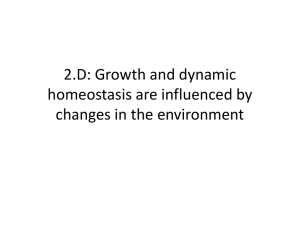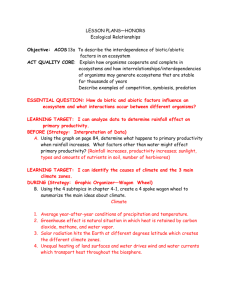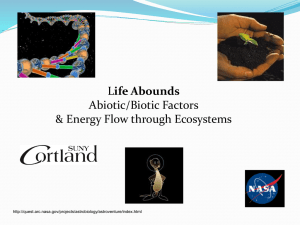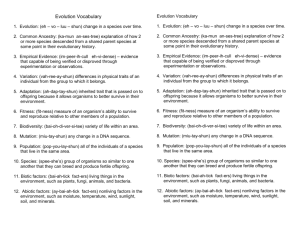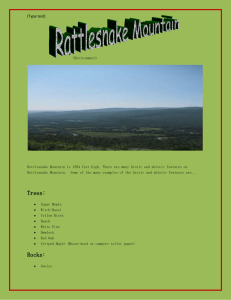Abiotic biotic GRC K-5
advertisement
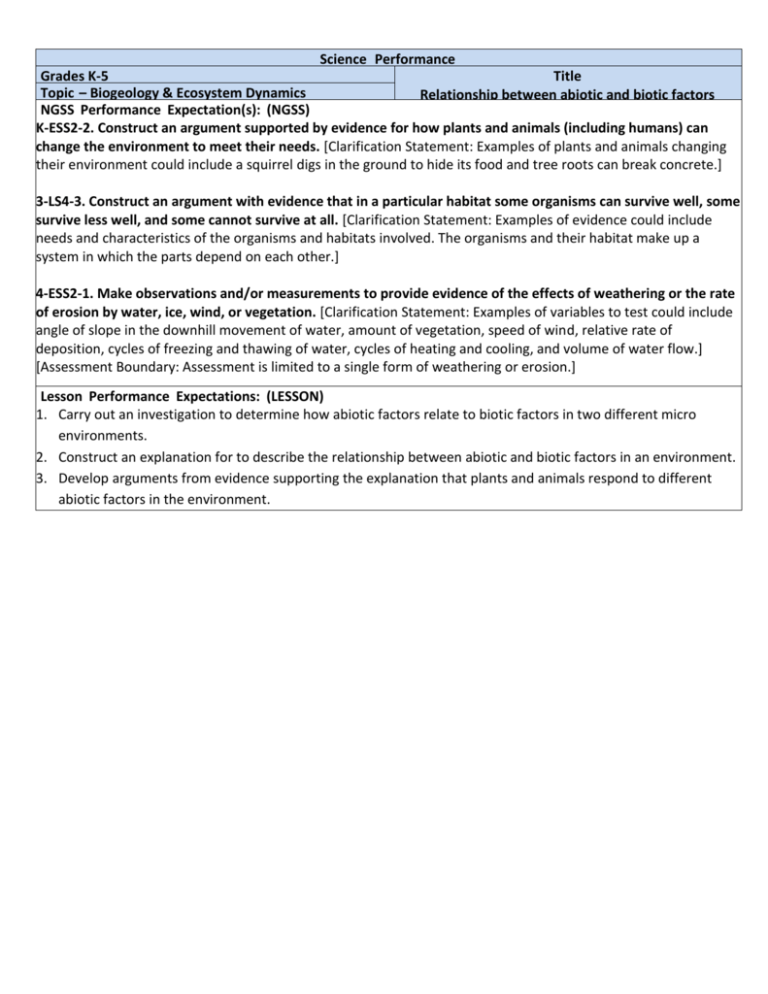
Science Performance Grades K-5 Title Topic – Biogeology & Ecosystem Dynamics Relationship between abiotic and biotic factors NGSS Performance Expectation(s): (NGSS) K-ESS2-2. Construct an argument supported by evidence for how plants and animals (including humans) can change the environment to meet their needs. [Clarification Statement: Examples of plants and animals changing their environment could include a squirrel digs in the ground to hide its food and tree roots can break concrete.] 3-LS4-3. Construct an argument with evidence that in a particular habitat some organisms can survive well, some survive less well, and some cannot survive at all. [Clarification Statement: Examples of evidence could include needs and characteristics of the organisms and habitats involved. The organisms and their habitat make up a system in which the parts depend on each other.] 4-ESS2-1. Make observations and/or measurements to provide evidence of the effects of weathering or the rate of erosion by water, ice, wind, or vegetation. [Clarification Statement: Examples of variables to test could include angle of slope in the downhill movement of water, amount of vegetation, speed of wind, relative rate of deposition, cycles of freezing and thawing of water, cycles of heating and cooling, and volume of water flow.] [Assessment Boundary: Assessment is limited to a single form of weathering or erosion.] Lesson Performance Expectations: (LESSON) 1. Carry out an investigation to determine how abiotic factors relate to biotic factors in two different micro environments. 2. Construct an explanation for to describe the relationship between abiotic and biotic factors in an environment. 3. Develop arguments from evidence supporting the explanation that plants and animals respond to different abiotic factors in the environment. Student Science Performance Gathering Carry out an investigation Students in groups of three (choose teammates from different school district) will be given the following equipment: LabQuests and sensors: wind speed, soil moisture, temperature, compass, meter stick, light reflectivity, collecting equipment—bug boxes, trays, forceps. Using these materials, have students determine what data they need to collect to answer the questions: How does the physical environment affect living things and how do living things affect their environment? Explain that they will be collecting data in two different microenvironments—deciduous hardwood forest and hemlock grove. Using these materials, have students determine what data they need to collect to answer these questions and justify why/how the data might be useful): (Teacher Hint: Have students note in their journals the details of their plan, including how/why the data might be useful. Students should collect data on soil moisture, light reflectivity, air temperature, soil temperature and wind speed. Students should use the meter stick to standardize the data collection sites if appropriate.) Reasoning: Students organize their data from each site in a way to make meaning, and to facilitate sharing with the other groups. (Teacher hint: organization of data should reflect grade level appropriate skills. i.e., determine how they can mathematically represent that data.) Reasoning Develop an Argument from Evidence Conduct a group discussion and engage students in argument from evidence. 1. How did the abiotic factors differ in each micro-environment? 2. How did the biotic factors differ in each micro-environment? 3. What is the relationship between the abiotic and biotic factors? 4. What evidence do you have for that relationship? 5. Was there evidence that the abiotic or biotic factors contributed to weathering or erosion? Communicating Construct and Explanation from Evidence Then have students construct an explanation about the relationship between the physical factors and the plants and animals in a particular environment. They support the explanation with evidence they collected from the investigation. Students individually write in their journals the explanation and use evidence to support their claim about the relationship.. Use the CER format (see below) *Assessment of Student Learning Have students’ propose where they might find the highest and lowest data points for each of the physical parameters and explain what vegetation types they would find in each spot and why. Science Essentials (Student Performance Expectations From Make careful observations Science Practices Appendix C, that D, E)generate evidence. Carry Out an Investigation Discuss and compare observations with others observing the same events. Construct an Explanation Explain scientific observations using evidence. Develop an Argument from Share explanations with others. Evidence Use evidence to support ideas. Use patterns to determine the causes of observed phenomena. Crosscutting Concepts Cause and effect Systems and Models Use evidence to support explanations for the causes of phenomena. Explain interactions across multiple systems. Analyze interactions within a system. Disciplinary Core Ideas Biogeology Adaptation Living things affect physical characteristics In any environment, some organisms survive well (B. Moulding, 2011)



